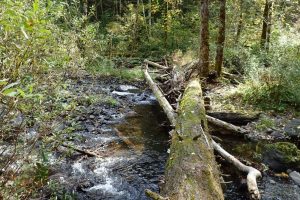[vc_row][vc_column][rescuepress_banner][/vc_column][/vc_row][vc_row css=”.vc_custom_1504071341536{padding-top: 50px !important;padding-bottom: 80px !important;}”][vc_column css=”.vc_custom_1519496486181{border-radius: 20px !important;}”][vc_row_inner content_placement=”middle” el_class=”container”][vc_column_inner][vc_column_text]

Project Description
The North Fork Clackamas River Restoration Project is located northeast of Estacada on federally managed Bureau of Land Management (BLM) property. There is a lot of excitement around this tributary of the mainstem Clackamas because it is considered one of the only viable habitat areas remaining for federally threatened coho salmon in the Lower Columbia River basin. This project aims to restore natural river processes to this historically pristine habitat through the addition of downed trees, boulders, and an enhanced forest canopy.
Project Investment: $210,884
Project Partners: Bureau of Land Management (BLM), U.S. Forest Service, Oregon Watershed Enhancement Board (OWEB)
Project Timeline: October 2017 – December 2020[/vc_column_text][/vc_column_inner][/vc_row_inner][/vc_column][/vc_row][vc_row css=”.vc_custom_1505022247579{padding-top: 20px !important;padding-bottom: 75px !important;background-color: #f1f3f5 !important;}”][vc_column][vc_row_inner el_class=”container”][vc_column_inner][vc_column_text]
Project Actions & Benefits
- Side channel enhancement – Historically this section of the Clackamas River boasted numerous side channels, log jams, and scour pools that were ideal habitat for salmon and steelhead. Over time however, humans have altered or removed these features through logging practices. This project identifies eight side channels, totaling 3,975 linear feet, that will be restored to provide critical spawning and rearing habitat for several ESA listed species.
- Stream enhancement – In the natural environment, streams have complex physical features like trees, boulders, and gravel that together create ideal spawning and rearing habitat for fish. This project will mimic these natural features through the addition of large wood and boulders. Over time these additions will naturally re-engineer stream flows and restore natural hydrology to the system.
- Floodplain reconnection – Healthy river systems have access to floodplains to allow for seasonal storage of water when the system is overwhelmed. This project will reconnect 8.5 acres of floodplain for the North Fork Clackamas River.
- Riparian restoration – In order for the floodplain and side channel habitats to fully function, the riparian forests around them have to be healthy. While there are some native species on the site, there are also invasive plant species which diminish soil health and out compete native plant species adapted to the site. To restore this 1.25 acre habitat, contractors will mechanically and chemically treat invasive plant species and then plant the area with native trees and shrubs.
[/vc_column_text][/vc_column_inner][/vc_row_inner][/vc_column][/vc_row]
